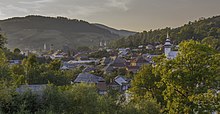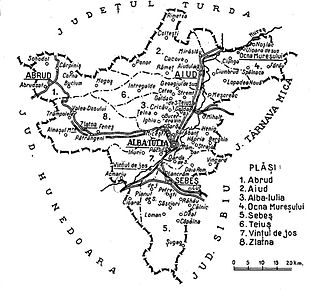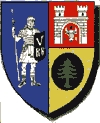|
Alba County
Alba County (Romanian pronunciation: [ˈalba]) is a county (județ) of Romania located in the historic region of Transylvania. Its capital is Alba Iulia, a city with a population of 63,536.[2] Name"Alba", meaning "white" in Latin and Romanian, is derived from the name of the city of Alba Iulia. In Hungarian, the county is known as Fehér megye (fehér also meaning white), and in German as Kreis Karlsburg. GeographyThis county has a total area of 6,242 km2 (2,410 sq mi), with mountains occupying about 59% of its surface. The Apuseni Mountains are in the northwest; the northeastern side of the Parâng Mountains group – the Șureanu and Cindrel mountains – are in the south. In the east there is the Transylvanian Plateau with deep but wide valleys. The three main elements are separated by the Mureș River valley. The main rivers are the Mureș River and its tributaries, the Târnava, the Sebeș, and the Arieș. Neighbors
EconomyThe predominant industries in the county are:
The mineral resources exploited in Alba county are metals (gold, silver, copper), salt, and construction materials, including marble and granite. Tourist attractions The main tourist attractions in the county are:
DemographicsAccording to the 2021 census, the county had a population of 325,941 and the population density was 52.2/km2 (135.2/sq mi).[5] Ethnic composition of Alba County (2021) Romanians (91.36%) Romani (4.43%) Hungarians (3.91%) Others (0.11%)
PoliticsThe Alba County Council, renewed at the 2020 local elections, consists of 32 county councillors, with the following party composition:[7]
Administrative divisions     Alba County has 4 municipalities, 7 towns, and 67 communes.
Historical county
Historically, Alba de Jos County was located in the central-western part of Greater Romania, in the southwestern part of Transylvania, with a territory identical with the old Alsó-Fehér County of Hungary. After the administrative unification law in 1925, the name of the county changed to Alba County and the territory was reorganized. It was bordered on the west by Hunedoara County, to the north by Turda County, and to the east by the counties of Sibiu and Târnava-Mică. Its territory included the central part of the current Alba County. Administration The county originally consisted of seven districts (plăși):[8]
Subsequently, Plasa Ighiu was abolished and two other districts were established, leaving these:
There were four towns: Alba Iulia, Abrud, Aiud, and Sebeș. PopulationAccording to the census data of 1930, the county's population was 212,749, of which 81.5% were Romanians, 11.3% Hungarians, 3.6% Germans, 1.8% Romanies, 1.4% Jews, as well as other minorities. In the religious aspect, the population consisted of 50.1% Eastern Orthodox, 31.6% Greek Catholics, 7.5% Reformed (Calvinists), 3.4% Roman Catholics, 3.3% Evangelical (Lutherans), 1.2% Unitarians, and other minorities.[9] Urban populationIn 1930, the urban population of the county was 33,365, of which 58.8% were Romanians, 23.0% Hungarians, 8.2% Germans, 6.2% Jews, 1.6% Romanies, as well as other minorities. From the religious point of view, the urban population was made up of 38.3% Eastern Orthodox, 21.4% Greek Catholic, 14.7% Reformed (Calvinist), 7.2% Evangelical (Lutheran), 6.5% Jewish, as well as other minorities.[9] After 1938After the 1938 Administrative and Constitutional Reform, this county merged with the counties of Ciuc, Odorhei, Sibiu, Târnava Mare, and Târnava Mică to form Ținutul Mureș. The county was re-established in 1940, but dissolved again in 1950. It was re-established in 1968 in its current borders. PeopleNotable natives include: ReferencesWikimedia Commons has media related to Alba County.
External linksWikivoyage has a travel guide for Alba County.
|
||||||||||||||||||||||||||||||||||||||||||||||||||||||||||||||||||||||||||||||||||||||||||||||||||||||||||||||||||||||||||||||||||||||||||||||||||||||||||||||||||||||||||||||||||||||||||||||||||||||||||||||||||||||||













